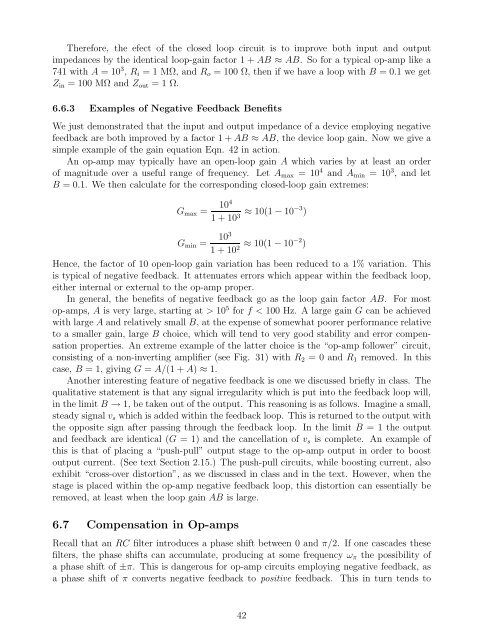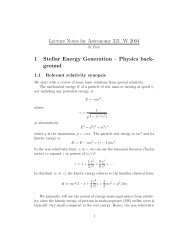Lecture Notes for Analog Electronics - The Electronic Universe ...
Lecture Notes for Analog Electronics - The Electronic Universe ...
Lecture Notes for Analog Electronics - The Electronic Universe ...
You also want an ePaper? Increase the reach of your titles
YUMPU automatically turns print PDFs into web optimized ePapers that Google loves.
<strong>The</strong>re<strong>for</strong>e, the efect of the closed loop circuit is to improve both input and output<br />
impedances by the identical loop-gain factor 1 + AB ≈ AB. So <strong>for</strong> a typical op-amp like a<br />
741 with A =10 3 ,Ri =1MΩ,andRo = 100 Ω, then if we have a loop with B =0.1weget<br />
Zin = 100 MΩ and Zout =1Ω.<br />
6.6.3 Examples of Negative Feedback Benefits<br />
We just demonstrated that the input and output impedance of a device employing negative<br />
feedback are both improved by a factor 1 + AB ≈ AB, the device loop gain. Now we give a<br />
simple example of the gain equation Eqn. 42 in action.<br />
An op-amp may typically have an open-loop gain A which varies by at least an order<br />
of magnitude over a useful range of frequency. Let Amax =10 4 and Amin =10 3 ,andlet<br />
B=0.1. We then calculate <strong>for</strong> the corresponding closed-loop gain extremes:<br />
Gmax = 104<br />
1+10 3 ≈10(1 − 10−3 )<br />
Gmin = 103<br />
1+10 2 ≈10(1 − 10−2 )<br />
Hence, the factor of 10 open-loop gain variation has been reduced to a 1% variation. This<br />
is typical of negative feedback. It attenuates errors which appear within the feedback loop,<br />
either internal or external to the op-amp proper.<br />
In general, the benefits of negative feedback go as the loop gain factor AB. For most<br />
op-amps, A is very large, starting at > 10 5 <strong>for</strong> f













